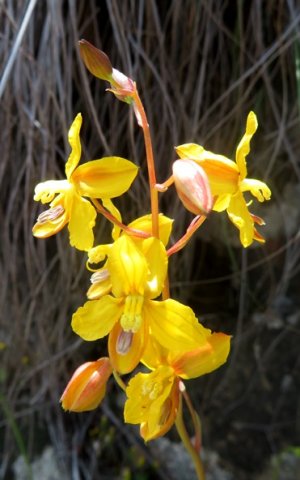Cyanella lutea subsp. lutea flowers

Author: Ivan Lätti
Photographer: Thabo Maphisa
The fragrant flowers of Cyanella lutea subsp. lutea grow in a loose raceme on spreading pedicels that curve up. The inflorescence may possibly be branched on some plants. Tiny bracts are visible in picture under the bases of the pedicels.
The wavy perianth segments of the flower grow in two whorls of three each. They are golden yellow as the Latin word lutea meaning yellow indicates. The segments of each perianth spread and recurve, obovate to elliptic in shape and longitudinally lined. The outside surfaces of the tepals are darker, as seen here on a bud at the top and old flower at the bottom of the inflorescence.
The six stamens here occur in two different-looking groups of three (or are differently configured). The upper three are smaller and cohering, yellow in filament and anther, while the lower three are longer, separate and the anthers brown or purplish grey. There may sometimes be four stamens in the cohering upper group, appearing like fingers.
The plant is sometimes called lady’s hand referring to the cohering anthers (Vlok and Schutte-Vlok, 2015; Privett and Lutzeyer, 2010; Manning, 2007; Mustart, 1997; iNaturalist).

